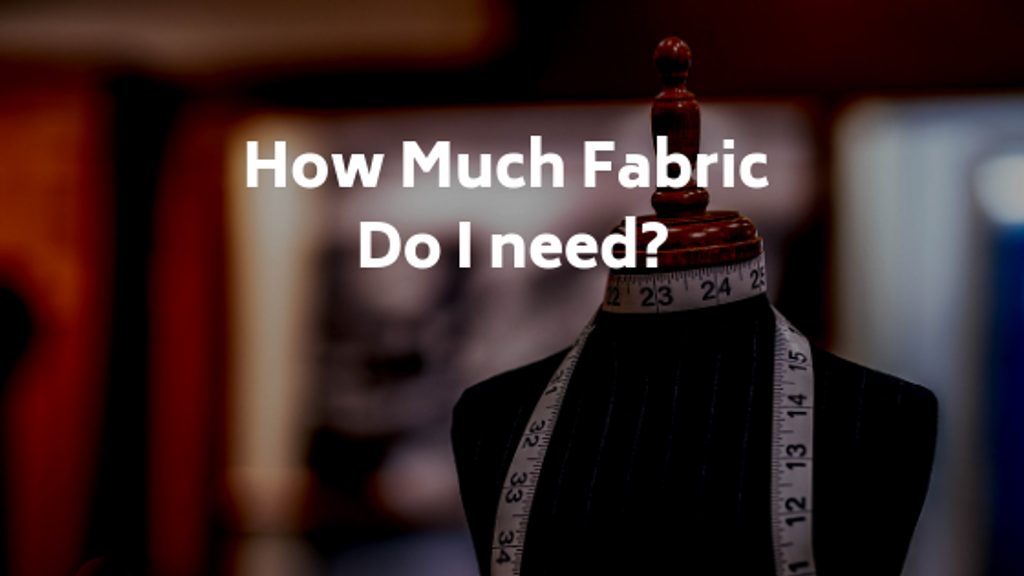How Much Fabric Do You Need?
Feb 23rd 2019
How Much Fabric Do I Need?
Sewing your own clothes is your chance to wear something unique and save some cash. You can choose the perfect material and customize your favorite model to suit your body measurements. You will also have the chance to pick the color, pattern, print, and add the accessories that make you look special. But a lot of beginners struggle when they are shopping for apparel fabric. How much fabric do I really need? How can I make sure that I have enough material to finish my sewing project?
Running out of fabric midst work is a bummer. You might not be able to find the same material which can ruin your entire sewing project. You shouldn’t also buy too much fabric because it is a waste of money. Sewing your own clothes helps you save money that you would normally spend to buy ready-made clothes that might not be of high-quality. It is a chance to change your bedding for an affordable price. You can even offer your tailoring and designing services to friends and family. Who knows…this might be your chance to for a fashion designing breakthrough. But before you get your hopes too high, there are a few basics that you need to take into consideration.
Check the Pattern:
Do you have a professional sewing pattern that you are going to follow? Sewing patterns usually come with easy instructions that tell you how much material you actually need to finish your favorite piece. Some patterns have several measurements for various sizes, others will ask you to do some calculations to make the necessary adjustments. Write down these numbers before deciding on the amount of material needed.
If you are designing your sewing pattern, then you need to make sure that you know how to take body measurements properly. After getting the correct body measurements, you will be able to figure out your size.
Different Fabrics have Different Widths:
There are a lot of different patterns and types of apparel fabrics on the market, but they come in different widths. The width ranges from 35 to 110 inches. You typically need less amount of material if the fabric is wider. Nevertheless, this rule doesn’t apply if you are working with certain patterns. If you have patterns that need to be correctly connected, you will need more yardage of the fabric. Typically speaking, if you are working with checks or flowers that have to match at the seams, you are going to need at least 25% more material. For an item that requires lining like chiffon or see-through mesh, you will have to buy the same amount of the lining and the original material.
Pants and bottom materials have widths that range from 58 to 60 inches. Dressmaking fabrics are usually narrower with a width of 36 inches. If the fabric is too narrow, you naturally need more yardage so you can connect it to execute your model.
Pay Attention to Measurements:
Don’t let yards and centimeters confuse you. Use a conversion table so you are working with the same unit throughout the whole project. Inches and yards are used in American catalogs while centimeters are used in other parts of the world. Bear this in mind to avoid unnecessary mistakes.
1 inch = 2.54 cm
39.3 inch = 1 meter
1 yard = 0.91 meter
How Much Fabric Do I Need?
Now it is time to buy your favorite apparel fabric. So how much material are you going to buy? Here is a guide that can help you:
Suit:
Formal suits are usually made using fabric of 58 inches wide. For an average person, you will need 2 meters or 2.18 yards of fabric for a jacket. To calculate the amount of material needed for pants, you have to measure the length, multiply it by 2 then add ¼ meters of fabric. An average person would need 1.3 meters while a tall person might need 1.4 meters. If you have a single width fabric, you simply have to use twice this amount.
Tops:
Shirts are usually made using a single width fabric that is 36 inches wide. You typically need 2.4 meters for a full-sleeved shirt and 2.2 meters for a half-sleeved shirt. Women’s tops might have more details on sleeves that require more material.
Dresses:
To have enough movement in a flared long dress you will have to buy at least 6 meters of apparel fabric. For the long sleeves, you must add an extra half meter. For the lining, you can buy 5 meters and half of the fabric. This will allow you to cut a circle skirt that will give you the flared look. Ruffles, drapes, ribbons, belts, and bows need an extra amount of fabric. Take that into consideration before shopping.
For A-line and casual dresses, you have to measure the length, double it then add ¼ meters of fabric. This amount is enough to create the A-line look. Add extra fabric for the sleeves, accessories, and ruffles.
Scarves:
Scarves can change the way your outfit looks and they don’t cost much. You can use scrap fabric to create a beautiful scarf that complements your look. Measure the length you need and sew the hems. You can also sew both ends for an infinity scarf that will keep you warm.
Pillows and Bedding:
You can save a lot of money by making pillow covers and bedspreads. For a bedspread, measure the length and width of the mattress then calculate the drop from the mattress to the floor or where you want the bedspread to stop. The amount of fabric you need depends on the width and length of the bedspread. The width equals the sum of width plus drop multiplied by 2. The length equals the length of the mattress multiplied by the drop. For a pillowcase, use 1.15 meters of material.
It is always a good idea to buy a little extra fabric in case of errors. Make sure that you leave allowance for the seams and hems to avoid unnecessary mistakes.




